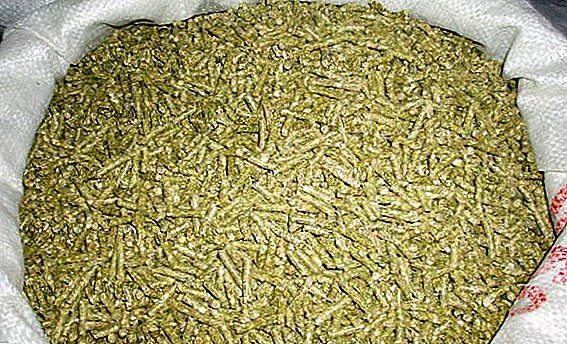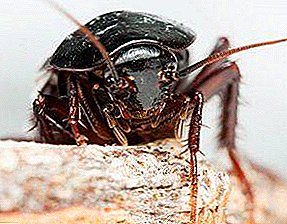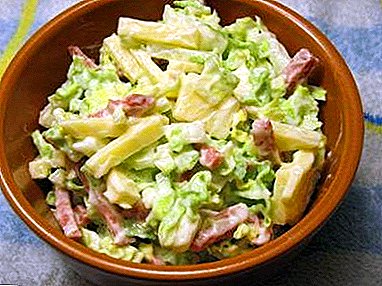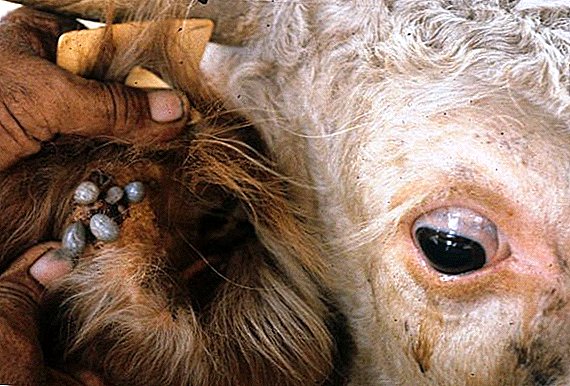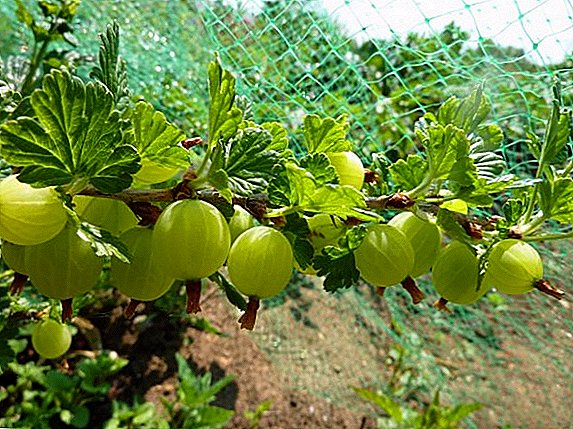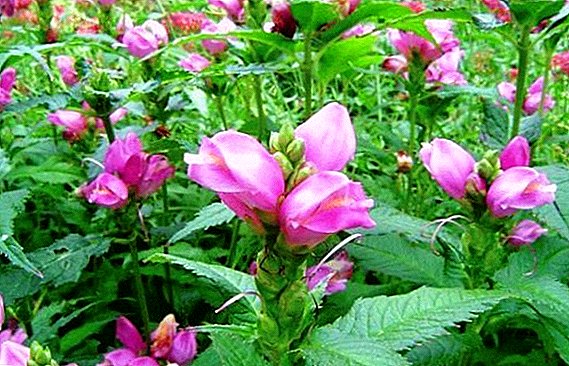 Helone is a very beautiful flower. Poetic natures like to compare its inflorescences with intertwining girlish braids. This tender, unpretentious plant will decorate any garden or garden plot with its juicy emerald leaves and rose buds.
Helone is a very beautiful flower. Poetic natures like to compare its inflorescences with intertwining girlish braids. This tender, unpretentious plant will decorate any garden or garden plot with its juicy emerald leaves and rose buds.
Botanical description
Chelone obligua, or helone oblique - the exact name of the flower from the botanical reference. It is a herbaceous plant with straight stems; it grows in small bushes about half a meter in height. Its pot-bellied buds resemble the flowers of lion's pharynx, but much larger, but the inflorescences are smaller and consist of only a few flowers. In nature, they most often have a pink color, but in the gardens you can find white and pink and even pure white Helone.

Dark green leaves have jagged edges and retain their freshness until the first frost. Artificially bred varieties may have variegated foliage.
Did you know? For its characteristic appearance, Helone the oblique was named "pink flamingo" and "perennial snapdragon."
The plant blooms late in August, but it blooms for a very long time. Do not be surprised if, once you go out into the garden, you will find beautiful buds under the first snow. And if the thaw then sets in, the resistant flower will continue its watch in the flower bed.

Distribution and habitat
Helone comes from wet Canadian meadows and forest edges. In Russia, an overseas beauty feels great in a temperate climate and does not require special conditions.
Throughout the season, such perennial plants will delight you with continuous decorativeness: host, Badan, astilba, geykher, hellebore, stonecrop, viola, tradescantia.
Use in landscape design
Resistance to diseases and pests, as well as a luxurious appearance make the flower an indispensable component of landscape design. This beautiful honey plant can be planted on its own, or it can be made a companion to other plants, such as phlox. Bright phlox compositions will slightly dilute the juicy greens of Helon and add color to its colors. It will also be a good combination with moisture-loving flowers, such as anafalis, Japanese iris, hibiscus, lobelia and others.

Helone for a pond or other artificial reservoir will be a special decoration. Do not be afraid to combine it with fern and sedge, stems and basil - this company will decorate the coast and get on well together.
Growing at home
Unpretentious and beautiful, Canadian perennial is popular among our gardeners. Therefore, it is necessary to know some features of growing a flower.
Conditions of detention
Helone loves the sun, but not direct sunlight. The best place in the garden for him is where the light lace shadow falls.

If you decide to grow Helone, then you should know that in a residential environment it is planted two months before the intended landing on the ground. Seedlings will germinate in two weeks, in rare cases, this time indicator stretches to 7 weeks. It is very important to maintain the correct temperature (15 ° C). Sprouts are planted not too close to each other, in increments of 20-30 cm. The soil is necessarily wet. Do not be afraid to overdo it - slightly boggy soil will not damage the flower.
In the garden, first lay a little fertilizer in the flower hole, then transplant there sprout. The depth of the root system is the same as it was in the container. After planting, the soil is mulched with 6 cm of organic compost. The final touch is watering.
Did you know? Helone bushes ripen and emerge at the same time, causing a special love of gardeners. Moreover, this feature does not depend on the quality of the soil.
Soil and fertilizer
The flower is so unpretentious that it can grow on almost any soil except frankly stony and dry. But slightly boggy soil will be ideal for our flower, it will quickly grow. The soil should be nutritious, so do not forget about organic dressing (for example, humus). Add them to the beginning of spring, after the last frost. Any mineral fertilizers are applied until flowering begins.

The optimum level of acidity is 5-7 pH. To determine it, you can purchase special indicators - test stripes.
It will be useful for you to learn more about the different types and properties of soil, fertilizer systems for them, how to independently determine the acidity of the soil on the site, how to deoxidize it, and also find out what it depends on and how to improve soil fertility.
Good drainage is another component of success. It must be maintained at the proper level constantly. Including for this reason, choose a shady site for planting, where the soil will not dry out for a long time. The best option is drainage with loams.

Watering and moisture
Helone does not need special care, and this is his main charm. If you choose the right place for planting, then you will not have to worry about the dry soil. The main thing is to water the flower on particularly hot summer days when there is no rain and it is not expected.
If there is a reservoir in the garden, planting a flower near it will solve all the difficulties with soil moistening. Watering has not been canceled, but the soil will stay wet longer.
Often, well-known annuals, such as petunia, nasturtium, convolvulus, cornflowers, marigolds, are also planted in gardens.
Breeding
Helone can be propagated in two ways. It is worth noting that both require good soil mulching.

Seeds
Seeds are sown directly into the soil before winter or late autumn, in spring - for seedlings. The plant will bloom in the second or third year after planting the seeds.
Seedlings' method is more practical, because flowering will come faster. In late March, seedlings are sown, in June shoots are planted in the garden. Already in the first year flowers may appear, but more often this period refers to the second year.

Vegetative
Reproduction division of rhizomes. This method is carried out in the spring. The bush is dug out and divided into parts, then each part is buried in a new place, on fertile soil. Before this, the cuts should be processed with charcoal. Further activities are reduced to the maintenance of moisture and timely feeding.
Important! Spend time weeding the bushes, it is very useful for the growth and development of Helon.
Reproduction by cuttings. Here work is carried out at a later period, when it is quite warm (late spring, summer). At this time, the stalk is planted in a hotbed, on loose soil, and only shoots from the top are used. Rooted plant in the shade, under the film. The seedling needs constant soil moisture. An established flower is planted in the open ground only in autumn.

Relation to temperature
Young flowers for the winter is good to cover the leaves, because they are not yet ready for wintering. When a plant is more than a year old, you can not worry - it perezimuet without additional measures, you do not need to cover it.
Pruning
Often it is not necessary to cut the helon bushes, because they grow slowly. All that is required of you is to remove the small amount of dry leaves that will appear during the year. When the flower has grown to a sufficiently large height and has become less resistant to gusts of wind, it can be tied up. Old leaves and stems are also subject to periodic (several times a year) removal.

If you are faced with the fact that pruning is necessary, then remember - pruned stems in late autumn, after flowering has ended. Places pruning need to mark, because you can damage the fragile roots during spring tillage.
Possible difficulties in growing
The only disadvantage experienced plant growers call the ability of "pink flamingo" to grow strongly and go in different directions from the main bush. Thus, the problem arises of dividing a bush every three years.
Pests, diseases and prevention
The flower is sufficiently resistant to diseases and pests, that, in addition to appearance and simplicity, also referred to the pluses of this plant. In especially rainy season, slugs appear, but their harm to the root system is minimal. Collect them with your hands, so as not to worry.

It is extremely rare to find "rust" on the leaves of Helon. It is a fungus that prevents normal metabolism and photosynthesis. However, the assistance provided in time will save the bush and the entire flowerbed.
Important! Rust flower lPrint Bordeaux liquid and only before flowering.
From powdery mildew, also rarely seen on Helon, fungicides will save.
Preventive measures can be called regular loosening of the soil for better ventilation and enrichment with oxygen.

Helone is rare and little-known, since gardeners do not often plant this beautiful flower as we would like. All because of the lack of information that we have tried today to fill. You are an experienced gardener, or a beginner amateur gardener - be sure to try to get the seeds of this overseas curiosity and plant it. The result will not disappoint you.



